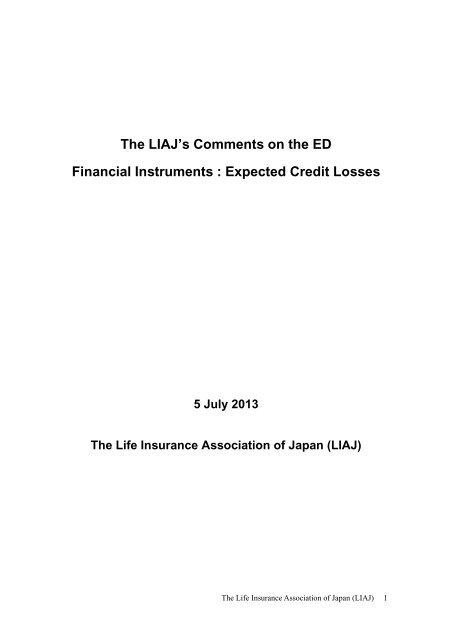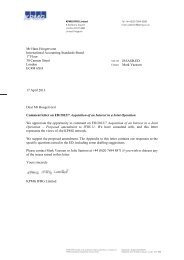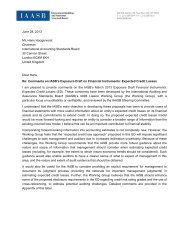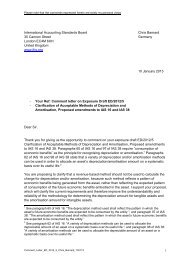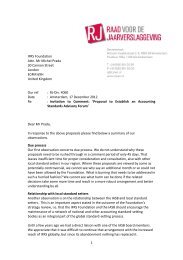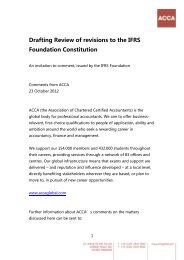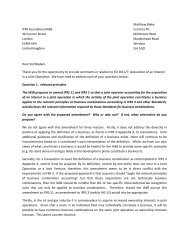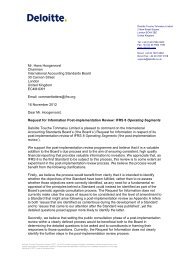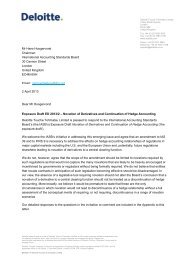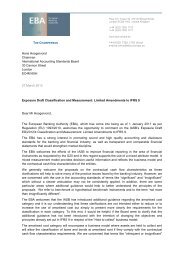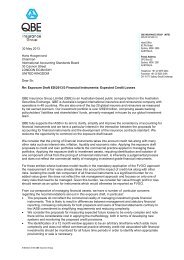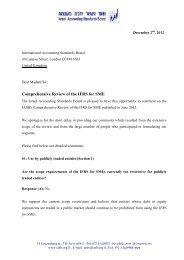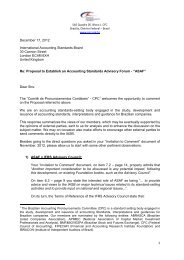Create successful ePaper yourself
Turn your PDF publications into a flip-book with our unique Google optimized e-Paper software.
The LIAJ’s Comments on the EDFinancial Instruments : <strong>Expected</strong> <strong>Credit</strong> <strong>Losses</strong>5 July 2013The Life Insurance Association of Japan (LIAJ)The Life Insurance Association of Japan (LIAJ) 1
Contents1. General opinions on the exposure draft1.1. Achieving convergence with the Financial Accounting StandardsBoard(FASB) on expected credit loss model1.2. Proposals for improvement to appropriately represent the life insurancebusiness2. Responses to the questions2.1. Question 12.2. Question 22.3. Question 32.4. Question 42.5. Question 52.6. Question 62.7. Question 72.8. Question 82.9. Question 92.10. Question 102.11. Question 112.12. Question 122.13. Question 13The Life Insurance Association of Japan (LIAJ) 2
1. General opinions on the exposure draft1. With our greatest respect to the continuing efforts of the International Accounting StandardsBoard (IASB) for financial instrument project, the Life Insurance Association of Japan (LIAJ)would like to extend our gratitude to the IASB for providing us with the opportunity to submitour comments on the exposure draft, Financial Instruments: <strong>Expected</strong> <strong>Credit</strong> <strong>Losses</strong> (hereinafterreferred to as ‘the exposure draft’), published in March 2013.2. The LIAJ is a trade association comprised of all 43 life insurance companies operating in Japan.Its aim is to promote the sound development of the life insurance industry and maintain itsreliability in Japan. We would like to respectfully request that the IASB carefully consider thecomments submitted from the sole representative body of the life insurance industry in Japan,which holds the second largest life insurance market in the world.3. We think that the proposed approach in the exposure draft has been improved compared toprevious approaches proposed in an exposure draft Financial Instruments: Amortised Cost andImpairment published in 2009 and a subsequent supplementary document FinancialInstruments: Impairment (SD) published in 2011, as it further considers entity's credit riskmanagement method, and therefore, we appreciate the proposed approach. However, as there arestill following serious concerns in practice, we think some improvement measures should betaken so that these concerns would be eliminated.‣ Burdensome practice of identifying deterioration in credit quality‣ Reflecting the time value of money in the estimates of expected credit losses‣ Application of expected credit loss model to bonds that have higher credit ratinggrades‣ Ensuring consistency between the financial supervisory requirements and theaccounting standards‣ Calculation and presentation of interest revenue from financial assets that areclassified as Stage 3‣ Disclosing carrying amount of financial assets by credit risk rating grades‣ Treatment of the effect of changes in contractual cash flows of a modified financialasset‣ Mandatory effective date[Burdensome practice of identifying deterioration in credit quality]4. We think that the approach for recognising expected credit losses proposed in the exposure drafthas been improved as mentioned above, and that this approach is well adapted to entity'sbusiness practice compared to the approach proposed by the FASB where an entity recognisesthe full lifetime expected credit losses since initial recognition.5. However, we do not agree with the proposal that financial instruments will be in stage 2 'whenthey have deteriorated significantly in credit quality since initial recognition'. This is because,from the cost-benefit perspective, the approach would incur significant operational burden onfinancial institutions that hold huge amount of financial assets, and it is different from the creditrisk management method that assesses the deterioration of financial assets by credit conditiononly at the end of the year.6. Although it is essential to spend entity's resources in estimating expected credit loss for financialThe Life Insurance Association of Japan (LIAJ) 3
assets with higher credit risk, we think that maintaining information about the credit quality offinancial assets since the initial recognition even for those that have lower credit risk would beof relative less importance.7. In addition, we have concerns that even for loans to the same counterparty, entity may berequired to apply different assessment of deterioration depending on the credit quality of theloans when they are acquired, and thus, this could lead to undermining the comparability offinancial statements.8. Accordingly, we believe that whether to move into stage 2 or not should be assessed accordingto the level of credit quality at the end of the year.[Reflecting the time value of money in the estimates of expected credit losses]9. With regard to the time value of money required to consider in estimating expected credit losses,we would like the IASB to give due consideration to current practice and allow a practicalexpedient that calculates the value multiplying the balance at the end of the year by default rate.[Application of expected credit loss model to bonds that have higher credit rating grades]10. With regard to the bonds with higher credit rating that are expected to result in no significantamount of impairment, we would like the IASB to allow a simplified approach where entitiesneed not apply impairment test, provided that they have referred to the external rating, or theyhave expediently observed that the market price of the bonds are higher than amortised cost ofthem. We also would like the IASB to allow entities to apply practical expedient for financialassets that are mandatorily measured at fair value through other comprehensive income(FVOCI) in the light of the convergence with the approach of the FASB.[Ensuring consistency between the financial supervisory requirements and the accounting standards]11. In estimating expected credit losses, for example, entities usually do not consider the credit riskof government bonds issued in their countries under the financial supervisory requirements. Thisis likely to be inconsistent with the proposals in the exposure draft. Therefore, we urge the IASBto hold active dialogue with national financial supervisors so that the difference between thefinancial supervisory requirements and the accounting standards would not lead to a greatturmoil in business practice.[Calculation and presentation of interest revenue from financial assets that are classified as Stage 3]12. Although we agree with the proposal that sets out limits in calculating interest revenue, we donot agree with the treatment stated in the Stage 3 that requires entities to calculate the interestrevenue on the net carrying amount reduced for expected credit losses.13. We think that, when the portion of interest for a loan is contractually easy to identify, presentinginterest revenue that is different from actually earned interest rate would lead to lessunderstandable information. Thus, we would like the IASB to allow the presentation of interestrevenue from such type of loan based on the actually earned interest rate.[Disclosing carrying amount of financial assets by credit risk rating grades]14. We are concerned that the proposal stated in paragraph 44 of the exposure draft, 'disclosing, bycredit risk rating grades, the gross carrying amount of financial assets and the amountrecognised as a provision for loan commitments and financial guarantee contracts' might containThe Life Insurance Association of Japan (LIAJ) 4
proprietary information that presents valuable corporate-competitive information particularly forfinancial institutions. Therefore, we would like the IASB to reconsider this proposal and decidenot to require disclosure of such information.[Treatment of the effect of changes in contractual cash flows of a modified financial asset]15. With regard to financial assets whose terms have been modified, as stated in the paragraph 19,entity shall recalculate the gross carrying amount on the basis of the modified contractual cashflows and shall recognise a modification gain or loss in profit or loss. We believe that it is notrelevant to recognise modification gain or loss tentatively in profit or loss.[Mandatory effective date]16. Our understanding is that as for impairment, the IASB's objective to develop commonimpairment model jointly with the FASB has not been achieved and there remain a number ofoutstanding issues.17. Therefore, we think that, together with due deliberation to resolve these issues, the IASB needsto provide sufficient time frame (e.g. three years) after the finalisation of IFRS 9, in settingmandatory effective date for IFRS 9. We also think that the IASB's flexible approach, such aspermitting ongoing application of existing IAS 39 should be needed.18. Also, as for insurers, there is a concern that insurers would be required to make two rounds ofmajor changes in the measurement of both assets and liabilities, since the IFRS 4: Insurancecontracts phase II is currently under deliberation. Besides, there might arise accountingmismatches in the measurement of financial assets and insurance liabilities due to the differencein implementation periods for financial instruments and insurance contracts. Amendments toaccounting standards for financial instruments that account for a large part of life insurers' assetsand developments of the project for insurance contracts that account for a large part of lifeinsurers' liabilities, would have a great impact on life insurers. Therefore, we believe that theeffective date for IFRS 9 for entities that are likely to apply IFRS 4 Insurance contracts phase IIshould be set at the later timing of completion of IFRS 9 or completion of IFRS 4.1.1. Achieving convergence with the Financial Accounting Standards Board(FASB)on expected credit loss model19. Because proposals stated in the exposure draft differ from the FASB's separately issuedproposals, in main part of those proposals, we are afraid that a significant differences havearisen between two proposals on expected credit losses. If the expected credit loss modelproposed by the IASB diverges from that of US GAAP without eliminating these differences,there may be a concern that the objective of financial statements to provide users of financialstatements with useful information for decision-making would be undermined and thus, thismight impair the benefits of users. Therefore, we believe that it is critical for the IASB toachieve convergence with the FASB's expected credit loss model in amending accountingstandards for financial instruments, and that the IASB needs to give due consideration throughcontinued deliberation with the FASB so that they can jointly develop a common operationalcredit loss model.1.2. Proposals for improvement to appropriately represent the life insurancebusinessThe Life Insurance Association of Japan (LIAJ) 5
20. We would like to note that, as we did in our comments submitted to the ED, Classification andMeasurement: Limited Amendments to IFRS 9 published in November 2011, the nature of lifeinsurance business is to underwrite risks over a long period and require insurers to firmly fulfilthe obligations to policyholders, instead of gaining profits through changes in fair value offinancial assets and liabilities they hold. Therefore, life insurers aim at long-term stable portfoliomanagement in their investments. Furthermore, life insurers invest in a wide range of assetsincluding foreign currency bonds, equities and investment trusts, in order to maintain the soundand well diversified portfolio. Thus, we believe that it is not appropriate to recognise suchshort-term changes in fair value of assets held in life insurers’ portfolio in profit or loss.21. In the process of amending IFRS 9 : Classification and Measurement, there are still outstandingissues which should be addressed, and we believe that the IASB needs to consider the followingimprovement:‣ Expanding the scope of assets to be measured at FVOCI‣ Eliminating the inconsistent requirement for recycling among assets to be measured atfair value through other comprehensive income (OCI) arising from limited permissionof recycling‣ Reducing the undue disclosure requirements for an entity that elects to present thechanges in fair value of equity instrument in other comprehensive income (so-calledOCI option)‣ Reconsidering the requirement regarding valuation of investments in equityinstruments that do not have a quoted market price and whose fair value cannot bereliably measured2. Responses to the questions2.1. Question 1(a) Do you agree that an approach that recognises a loss allowance (or provision) at an amountequal to a portion of expected credit losses initially, and lifetime expected credit losses onlyafter significant deterioration in credit quality, will reflect:(i) the economic link between the pricing of financial instruments and the credit quality atinitial recognition; and(ii) the effects of changes in the credit quality subsequent to initial recognition?If not, why not and how do you believe the proposed model should be revised?(b) Do you agree that recognising a loss allowance or provision from initial recognition at anamount equal to lifetime expected credit losses, discounted using the original effective interestrate, does not faithfully represent the underlying economics of financial instruments? If not,why not?[We do not agree with the approach for recognising a lifetime credit losses depending ondeterioration in credit quality]22. We think that the proposed approach in the exposure draft has been improved compared toprevious approaches proposed in an exposure draft Financial Instruments: Amortised Cost andImpairment published in 2009 and a subsequent supplementary document FinancialInstruments: Impairment (SD) published in 2011, as it further considers not only the entity'sThe Life Insurance Association of Japan (LIAJ) 6
credit risk management method, but also the practical burden imposed on them, and therefore,we appreciate the proposed approach.23. Furthermore, we think that the IASB's approach is well adapted to entity's business practicecompared to the approach proposed by the FASB where an entity recognises the full lifetimeexpected credit losses since initial recognition, as an entity is likely to overstate provision foridentified expected credit losses.24. However, we do not agree with the proposal that financial instruments will be in stage 2 'whenthey have deteriorated significantly in credit quality since initial recognition'. This is because,from the cost-benefit perspective, the approach would incur significant operational burden onfinancial institutions that hold huge amount of financial assets, and it is different from the creditrisk management method that assesses the deterioration of financial assets by credit conditiononly at the end of the year.25. Although it is essential to spend entity's resources in estimating expected credit loss for financialassets with higher credit risk, we think that maintaining information about the credit quality offinancial assets since the initial recognition even for those that have lower credit risk would beof relative less importance.26. In addition, we have concerns that even for loans to the same counterparty, entity may berequired to apply different assessment of deterioration depending on the credit quality of theloans when they are acquired, and thus, this could lead to undermining the comparability offinancial statements.27. Accordingly, we believe that whether to move into stage 2 or not should be assessed accordingto the level of credit quality at the end of the year.2.2. Question 2(a) Do you agree that recognising a loss allowance (or provision) at an amount equal to 12-monthexpected credit losses and at an amount equal to lifetime expected credit losses after significantdeterioration in credit quality achieves an appropriate balance between the faithfulrepresentation of the underlying economics and the costs of implementation? If not, why not?What alternative would you prefer and why?(b) Do you agree that the approach for accounting for expected credit losses proposed in thisExposure Draft achieves a better balance between the faithful representation of the underlyingeconomics and the cost of implementation than the approaches in the 2009 ED and the SD(without the foreseeable future floor)?(c) Do you think that recognising a loss allowance at an amount equal to the lifetime expectedcredit losses from initial recognition, discounted using the original effective interest rate,achieves a better balance between the faithful representation of the underlying economics andthe cost of implementation than this Exposure Draft?[We do not agree with the approach for recognising a lifetime credit losses depending ondeterioration in credit quality]28. We think that the proposed approach in the exposure draft has been improved compared toprevious approaches proposed in a exposure draft Financial Instruments: Amortised Cost andThe Life Insurance Association of Japan (LIAJ) 7
Impairment published in 2009 and a subsequent supplementary document FinancialInstruments: Impairment (SD) published in 2011, as it further considers not only the entity'scredit risk management method, but also the practical burden imposed on them, and therefore,we appreciate the proposed approach.29. Furthermore, we think that the IASB's approach is well adapted to entity's business practicecompared to the approach proposed by the FASB where an entity recognises the full lifetimeexpected credit losses since initial recognition, as an entity is likely to overstate provision foridentified expected credit losses.30. However, we do not agree with the proposal that financial instruments will be in stage 2 'whenthey have deteriorated significantly in credit quality since initial recognition'. This is because,from the cost-benefit perspective, the approach would incur significant operational burden onfinancial institutions that hold huge amount of financial assets, and it is different from the creditrisk management method that assesses the deterioration of financial assets by credit conditiononly at the end of the year.31. Although it is essential to spend entity's resources in estimating expected credit loss for financialassets with higher credit risk, we think that maintaining information about the credit quality offinancial assets since the initial recognition even for those that have lower credit risk would beof relative less importance.32. In addition, we have concerns that even for loans to the same counterparty, entity may berequired to apply different assessment of deterioration depending on the credit quality of theloans when they are acquired, and thus, this could lead to undermining the comparability offinancial statements.33. Accordingly, we believe that whether to move into stage 2 or not should be assessed accordingto the level of credit quality at the end of the year.2.3. Question 3(a) Do you agree with the proposed scope of this Exposure Draft? If not, why not?(b) Do you agree that, for financial assets that are mandatorily measured at FVOCI inaccordance with the Classification and Measurement ED, the accounting for expected creditlosses should be as proposed in this Exposure Draft? Why or why not?[We do not agree on some part of the proposals]34. With regard to the bonds with higher credit rating that are expected to result in no significantamount of impairment, we would like the IASB to allow a simplified approach where entitiesneed not apply impairment test, provided that they have referred to the external rating, or theyhave expediently observed that the market price of the bonds are higher than amortised cost ofthem. We also would like the IASB to allow entities to apply practical expedient for financialassets that are mandatorily measured at fair value through other comprehensive income(FVOCI) in the light of the convergence with the approach of the FASB.35. Furthermore, we would like the IASB to ensure consistency between the financial supervisoryrequirements and the accounting standards. For example, entities usually do not consider theThe Life Insurance Association of Japan (LIAJ) 8
credit risk of government bonds issued in their countries under the financial supervisoryrequirements. This is likely to be inconsistent with the proposals in the exposure draft. Therefore,we urge the IASB to hold active dialogue with national financial supervisors so that thedifference between the financial supervisory requirements and the accounting standards wouldnot lead to a great turmoil in business practice.2.4. Question 4Is measuring the loss allowance (or a provision) at an amount equal to 12-month expected creditlosses operational? If not, why not and how do you believe the portion recognised from initialrecognition should be determined?[Application for higher-credit-rating bonds need to considered]36. We agree with the proposal that requires an entity to measure loss provision at an amount equalto 12-month expected credit losses on loan. However, with regard to the time value of moneyrequired to consider in estimating expected credit losses, we would like the IASB to give dueconsideration to current practice and allow a practical expedient that calculates the valuemultiplying the balance at the end of the year by default rate.37. In applying the approach proposed in the exposure draft to bonds, if the bonds have higher creditrating and are expected to result in no significant amount of impairment, we would like theIASB to allow a simplified approach where entities need not apply impairment test, providedthat they have referred to the external rating, or they have expediently observed that the marketprice of the bonds are higher than amortised cost of them. We also would like the IASB to allowentities to apply practical expedient for financial assets that are mandatorily measured at fairvalue through other comprehensive income (FVOCI) in the light of the convergence with theapproach of the FASB.38. Furthermore, we would like the IASB to ensure consistency between the financial supervisoryrequirements and the accounting standards. For example, entities usually do not consider thecredit risk of government bonds issued in their countries under the financial supervisoryrequirements. This is likely to be inconsistent with the proposals in the exposure draft. Therefore,we urge the IASB to hold active dialogue with national financial supervisors so that thedifference between the financial supervisory requirements and the accounting standards wouldnot lead to a great turmoil in business practice.2.5. Question 5(a) Do you agree with the proposed requirement to recognise a loss allowance (or a provision) atan amount equal to lifetime expected credit losses on the basis of a significant increase incredit risk since initial recognition? If not, why not and what alternative would you prefer?(b) Do the proposals provide sufficient guidance on when to recognise lifetime expected creditlosses? If not, what additional guidance would you suggest?(c) Do you agree that the assessment of when to recognise lifetime expected credit losses shouldconsider only changes in the probability of a default occurring, rather than changes inexpected credit losses (or credit loss given default (‘LGD’))? If not, why not and what wouldyou prefer?The Life Insurance Association of Japan (LIAJ) 9
(d) Do you agree with the proposed operational simplifications, and do they contribute to anappropriate balance between faithful representation and the cost of implementation?(e) Do you agree with the proposal that the model shall allow the re-establishment of a lossallowance (or a provision) at an amount equal to 12-month expected credit losses if the criteriafor the recognition of lifetime expected credit losses are no longer met? If not, why not, andwhat would you prefer?[We do not agree with the approach for recognising a lifetime credit losses depending ondeterioration in credit quality]39. We think that the proposed approach in the exposure draft has been improved compared toprevious approaches proposed in an exposure draft Financial Instruments: Amortised Cost andImpairment published in 2009 and a subsequent supplementary document FinancialInstruments: Impairment (SD) published in 2011, as it further considers not only the entity'scredit risk management method, but also the practical burden imposed on them, and therefore,we appreciate the proposed approach.40. Furthermore, we think that the IASB's approach is well adapted to entity's business practicecompared to the approach proposed by the FASB where an entity recognises the full lifetimeexpected credit losses since initial recognition, as an entity is likely to overstate provision foridentified expected credit losses.41. However, we do not agree with the proposal that financial instruments will be in stage 2 'whenthey have deteriorated significantly in credit quality since initial recognition'. This is because,from the cost-benefit perspective, the approach would incur significant operational burden onfinancial institutions that hold huge amount of financial assets, and it is different from the creditrisk management method that assesses the deterioration of financial assets by credit conditiononly at the end of the year.42. Although it is essential to spend entity's resources in estimating expected credit loss for afinancial assets with higher credit risk, we think that maintaining information about the creditquality of financial assets since the initial recognition even for those that have lower credit riskwould be of relative less importance.43. In addition, we have concerns that even for loans to the same counterparty, entity may berequired to apply different assessment of deterioration depending on the credit quality of theloans when they are acquired, and thus, this could lead to undermining the comparability offinancial statements.44. Accordingly, we believe whether to move into stage 2 or not should be assessed according to thelevel of credit quality at the end of the year.2.6. Question 6(a) Do you agree that there are circumstances when interest revenue calculated on a net carryingamount (amortised cost) rather than on a gross carrying amount can provide more usefulinformation? If not, why not, and what would you prefer?(b) Do you agree with the proposal to change how interest revenue is calculated for assets thathave objective evidence of impairment subsequent to initial recognition? Why or why not? IfThe Life Insurance Association of Japan (LIAJ) 10
not, for what population of assets should the interest revenue calculation change?(c) Do you agree with the proposal that the interest revenue approach shall be symmetrical (ie thatthe calculation can revert back to a calculation on the gross carrying amount)? Why or whynot? If not, what approach would you prefer?[We do not agree with the proposal]45. Although we agree with the proposal that sets out limits in calculating interest revenue, we donot agree with the treatment stated in the Stage 3 that requires entities to calculate the interestrevenue on the net carrying amount reduced for expected credit losses.46. We think that, when the portion of interest for a loan is contractually easy to identify, presentinginterest revenue that is different from actually earned interest rate would lead to lessunderstandable information. Thus, we would like the IASB to allow the presentation of interestrevenue from such type of loan based on the actually earned interest rate.2.7. Question 7(a) Do you agree with the proposed disclosure requirements? Why or why not? If not, whatchanges do you recommend and why?(b) Do you foresee any specific operational challenges when implementing the proposeddisclosure requirements? If so, please explain.(c) What other disclosures do you believe would provide useful information (whether in additionto, or instead of, the proposed disclosures) and why?[We do not agree with the proposal]47. We are concerned that the proposal stated in paragraph 44 of the exposure draft, 'disclosing, bycredit risk rating grades, the gross carrying amount of financial assets and the amountrecognised as a provision for loan commitments and financial guarantee contracts' might containproprietary information that presents valuable corporate-competitive information particularly forfinancial institutions. Therefore, we would like the IASB to reconsider this proposal and decidenot to require disclosure of such information.2.8. QuestionDo you agree with the proposed treatment of financial assets on which contractual cash flows aremodified, and do you believe that it provides useful information? If not, why not and whatalternative would you prefer?[We do not agree with the proposal]48. With regard to financial assets whose terms have been modified, as stated in the paragraph 19,entity shall recalculate the gross carrying amount on the basis of the modified contractual cashflows and shall recognise a modification gain or loss in profit or loss. We believe that it is notrelevant to recognise modification gain or loss tentatively in profit or loss.2.9. Question 9The Life Insurance Association of Japan (LIAJ) 11
(a) Do you agree with the proposals on the application of the general model to loan commitmentand financial guarantee contracts? Why or why not? If not, what approach would you prefer?(b) Do you foresee any significant operational challenges that may arise from the proposal topresent expected credit losses on financial guarantee contracts or loan commitments as aprovision in the statement of financial position? If yes, please explain.[We do not agree with the proposal]49. Although the IASB rejected an alternative that allows entities to estimate future drawdownsfrom loan commitments based only on historical information as stated in BC133 of the exposuredraft, we believe that the IASB should allow another alternative that enables entities to estimatethose drawdowns based only on historical performance according to the importance of theperformance within entities.2.10. Question 10(a) Do you agree with the proposed simplified approach for trade receivables and leasereceivables? Why or why not? If not, what changes do you recommend and why?(b) Do you agree with the proposed amendments to the measurement on initial recognition oftrade receivables with no significant financing component? If not, why not and what wouldyou propose instead?[No comment]2.11. Question 11Do you agree with the proposals for financial assets that are credit-impaired on initialrecognition? Why or why not? If not, what approach would you prefer?[No comment]2.12. Question 12(a) What lead time would you require to implement the proposed requirements? Please explain theassumptions that you have used in making this assessment. As a consequence, what do youbelieve is an appropriate mandatory effective date for IFRS 9? Please explain.(b) Do you agree with the proposed transition requirements? Why or why not? If not, whatchanges do you recommend and why?(c) Do you agree with the proposed relief from restating comparative information on transition? Ifnot, why?50. We believe that at least three years will be required after the completion of accounting standardsfor expected credit losses, because entities will need to develop methods and systems forestimating future events and prepare large-scale operational infrastructure in order to meet theappropriate level required in the exposure draft.51. Accordingly, we believe that the current proposal that sets mandatory effective date for annualperiods beginning on or after 1 January 2015 is not appropriate.The Life Insurance Association of Japan (LIAJ) 12
52. Also, as for insurers, there is a concern that insurers would be required to make two rounds ofmajor changes in the measurement of both assets and liabilities, since the IFRS 4: Insurancecontracts phase II is currently under deliberation. Besides, there might arise accountingmismatches in the measurement of financial assets and insurance liabilities due to the differencein implementation periods for financial instruments and insurance contracts. Amendments toaccounting standards for financial instruments that account for a large part of life insurers' assetsand developments of the project for insurance contracts that account for a large part of lifeinsurers' liabilities, would have a great impact on life insurers. Therefore, we believe that theeffective date for IFRS 9 for entities that are likely to apply IFRS 4 Insurance contracts phase IIshould be set at the later timing of completion of IFRS 9 or completion of IFRS 4.2.13. Question 13Do you agree with the IASB’s assessment of the effects of the proposals? Why or why not?[No comment]The Life Insurance Association of Japan (LIAJ) 13


